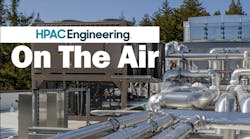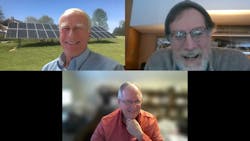HPAC 'On The Air': ASHRAE's New Focus on Decarbonization
This month's guests are two accomplished engineers and past presidents of ASHRAE, Dr. Donald Colliver from the University of Kentucky and Thomas Phoenix, of Mechanical Contractors Inc. in Charlotte NC. The highly experienced pair have been linked since last spring as co-chairs of ASHRAE's new Task Force for Building Decarbonization (TFBD).
This is an ambitious and important new effort that our listeners have heard referenced in prior podcast episodes with current ASHRAE President Mick Schwedler, as well as his predecessor, Chuck Gulledge. It was Gulledge who launched the TFBD in 2021 and intentionally patterned it after the successful ASHRAE Epidemic Task Force that was urgently birthed by the pandemic.
Here, Colliver and Phoenix explain how their task force came together, what they hope to achieve, and why they think it is worth everyone's attention. Please listen and share...
EDITED TRANSCRIPT:
HPAC: Gentlemen, welcome. Let's first dive into your backgrounds a bit. Please tell us how your careers and involvement with ASHRAE and sustainability efforts over the years have led you to lead this key task force.
Don Colliver: Thank you, Rob. And thanks for this opportunity to talk about the new task force. There are a lot of exciting things going on with it. In response to your question, I have been doing research and teaching in the HVAC area and the design of efficient buildings for 40-plus years or so. I got involved in ASHRAE first as a student and then later as a faculty member involved in its research program and standards development. Eventually, I became Society president in 2002. During that time, I had come to realize that many design professionals were looking for guidance on buildings and designs that were better than just the code minimums. I envisioned that if we broke down the silos in the built environment and brought professionals together that we might be able to provide this guidance. Working with AIA, and U.S. Green Building Council, and IES, and U.S. DOE, we pulled together a team to start development of the Advanced Energy Design Guide (AEDG). I subsequently served as chair of that group for over 10 years, and by 2013, we had over 50,000 copies of AEDGs in distribution. I believe this is what led to me being requested to work on this particular project.
Tom Phoenix: First, let me echo Don's thanks for allowing us to talk about the task force. As for me, I'm a consulting engineer and I have worked in this business for a long time... When I first started, I was invited to join the local ASHRAE chapter, and the rest is history, as they say. I was ASHRAE president in 2014-15, and I am still very involved. The AEDG committee that Don just described, I am the current chair of that committee, and have been for the last six years. I also serve on the board of the National Institute of Building Sciences in Washington., where I am the current Vice Chair. Like Don, I got a call from Chuck Gulledge and Mick Schwedler last spring that said, "Hey, we need to get into this decarbonization world. Would you be willing to co-chair this with Don?" And I enthusiastically agreed. The world of energy efficiency and now carbon reduction has been our focus, speaking for Don and myself, for a long, long time. And I think that's why we are here today.
HPAC: Please give us some more details about the work and goals of the task force.
Phoenix: Sure. We were appointed initially by President Gulledge and then re-appointed this year by President Schwedler. We have 15 members, including some from Europe and the Far East. So there is global representation on the task force. Early on, we identified key areas of concern that we needed to focus on to address the decarbonization problem in buildings. We came up with nine areas of concern and assigned members to chair individual working groups for those areas. Those chairs were then asked to populate their working groups with experts in those areas from all over the world, whether they were inside ASHRAE or outside. So now we have over 120 volunteers participating in those very active working groups. One is now working on a position document on decarbonization for ASHRAE to approve. Others are working on things like Embodied Carbon, Grid Interaction, Overall Building Performance, Operational Carbon Issues, etc. So, that's what we've been doing for just about a year now, since the working groups got started last April.
HPAC: Since the TFBD was patterned after the Epidemic Task Force, which arose from a global emergency, it would seem that urgency is built into its DNA. What is driving that sense of urgency and how is the task force structured to deliver on its work sooner than later?
Colliver: Why are we looking at decarbonization as being so urgent now? Well, let's consider that a number of things are driving this. First of all, population growth. Earth's population over the next 30 years is anticipated to grow by 2.4 billion people. That's a 25% increase. To meet the needs that this population growth will create, we will need to have building growth, which itself is now anticipated to increase by 2.5 trillion sq ft globally by 2060. To put that in perspective, it means that we will need to construct an entire New York City... every month! Or an entire city of Paris... every week! And consider also that at least half of all the buildings that will be standing in 2060 have yet to be built!
We have to understand that the built environment really has a great impact on greenhouse gas emissions, or carbon emissions. About 11% of all greenhouse gas emissions can be attributed to building materials in construction, and 28% is from building operations. So we're talking about all of the built environment contributing about 39%. By comparison, transportation is only 22%, and industry is at 30%. Therefore, the built environment, by far, has the largest impact.
Now, scientists also tell us that we need to limit the global temperature rise to 2 degrees Celsius, and strongly recommend that we retain it to 1.5 degrees Celsius. In order to meet these goals, emissions from buildings will need to be significantly reduced. In fact, models project that these emissions from buildings will need to be reduced about 65% in the next eight years. And that's just decarbonization. So, it's not total net zero, which is where we need to get to by 2050.
Phoenix: We are working to a deadline. So the urgency just described is very real. Each one of our working groups is working to develop deliverables, which is a pretty broad definition. It can include things like just gathering information. One of our groups, basically, is what we call "The Library," our Research & Knowledge Working Group, which is gathering up all the information it can find about this. So, our deliverables can include new documentation, new research, and certainly new tools that practitioners in our business can use. And we are working to get all of these deliverables out into the hands of people as quickly as possible. We just did eight seminars at our ASHRAE winter meeting in Las Vegas. And now we have the International Conference on Decarbonization scheduled for October in Athens, Greece. So, there is a lot going on, and this really has turned into almost a full-time job on its own. That's not a complaint. It's just a reflection of the urgency involved here.
HPAC: From your long experience in the field, in research, in business and in academia, do you both believe that building owners, both public and private, will now be ready and willing to act on the recommendations of your task force?
Colliver: Well, first, this really is more than just about our recommendations. The Society is adding carbon reduction to its portfolio now, but it has been working in energy efficiency for many, many years... In response to your question, we already have many owners, designers and agencies in both state and local governments that are already asking for this information. Many states and provinces have already set goals for decarbonization, but it hasn't really been determined yet how those goals are going to be reached. So, our purpose is to help the built environment reach those goals. Now, as with anything new, there is going to be some hesitancy in acting. But what ASHRAE is trying to do is to provide some good, solid guidance for those who are wanting to reduce the impact of buildings on CO2-equivalent emissions.
Phoenix: I would say that I have actually seen the answer to this question change in just the last 12 months, since we were appointed to the task force. As a consulting engineer, I work with clients both public and private who want us to design their buildings. Even just a year ago, there was hesitancy if you would say to them, "Can we start talking about zero carbon?" Their perception was, and this was the same with energy efficiency goals, was that this was going to cost a lot more money. What has happened, though, and again, this was just in the last several months, is that building owners have begun to become very aware of the severity of the issue and the urgency to try to address it. So they are now much more willing to talk about how to get to zero carbon. More and more of our clients are aware of that now and the need to address this quickly.
Colliver: I agree with that, and I've worked a lot on industrial energy assessments, as well. I was working with a company recently and they put in a $15-million solar system. I asked them what their economics were on that decision. Their response was, "Well, we wanted to be perceived as a green company. So therefore, it came out of our advertising budget!" So, other factors are contributing to this effort now that are making me think it's going to get done.
HPAC: Finally, you are both very accomplished engineers with more than 40 years of experience. Many contemporaries have likely retired at this point. So, what is driving you both to give back to the profession at this level and to remain this active?
Phoenix: Well, I had the opportunity to retire only last year, but I decided against it. Only because I'm still very passionate about this. And as long as your health allows you to continue to participate, and to help, and to add something to the conversation, then that's what drives me. I've always enjoyed being in the industry and I'm really not ready to give that up after all these years.
Colliver: I agree with Tom, and I think you have heard the passion that we both have for this. Yes, it is tempting to look at slowing down, however I feel that all of my experiences have put me in a unique position to address something that is important to my grandchildren and those that are coming after them. My faith calls for us to be good stewards of our resources. Through this effort, I can now see the rewards of putting into practice these many years of hard work. But I think there are a lot of other people who have these experiences who are willing to contribute, as well.
##########
To listen to previous 'HPAC On The Air' podcasts, visit our Members Only page.
About the Author
Rob McManamy
Editor in Chief
An industry reporter and editor since 1987, McManamy joined HPAC Engineering in September 2017, after three years with BuiltWorlds.com, a Chicago-based media startup focused on tech innovation in the built environment. He has been covering design and construction issues for more than 30 years, having started at Engineering News-Record (ENR) in New York, before becoming its Midwest Bureau Chief in 1990. In 1998, McManamy was named Editor-in-Chief of Design-Build magazine, where he served for four years. He subsequently worked as an editor and freelance writer for Building Design + Construction and Public Works magazines.
A native of Bronx, NY, he is a graduate of both the University of Virginia, and The John Marshall Law School in Chicago.
Contact him at [email protected].


